Advances in Animal and Veterinary Sciences
Research Article
Impact of Formaldehyde Upon Anxiety and Cognitive Behavior in Wistar Rats Following Curcumin Administration
Mouna Nouacer*, Abdelkrim Tahraoui, Amira Bakeche, Ibtissem Chouba, Mohamed Lamine Benabed, Sabri Benkermiche
Applied Neuroendocrinology Laboratory Department of Biology; Faculty of Sciences; University Badji Mokhtar Annaba, 23000, Algeria.
Abstract | Formaldehyde is a colorless and flammable gas that is created and evaporated at room temperature and often commercialized in a liquid form commonly called formalin. Formaldehyde has been known as an air pollutant that accumulates in the human body. Through the present research, we analyzed the effects of formaldehyde on the anxiety and cognitive abilities of WISTAR rats on the one hand. On the other hand, we have proven the restorative effect of an antioxidant, curcumin, which has the role of regulating the complications induced by the administration of the toxic product. A total of twenty-five white rats of Wistar strains (250 ± 50 grams) were separated into 5 experimental batches: control batch (T) [n = 5], vehicle control batch (CV) [n = 5], control curcumin batch (CC) [n = 5], one batch formaldehyde vehicle (FV) [n = 5] and one batch formaldehyde curcumin (FC) [n = 5]. Diluted formaldehyde was administered by a single intraperitoneal injection at a dose of 10 mg/kg, while Curcuma longa L.turmeric dissolved in olive oil was administered by gastric tube feeding at a dose of (60 mg/kg). Our results showed that formaldehyde resulted in a disturbance in the weight and behavior of rats and also revealed the therapeutic benefits of curcumin. This experiment made it possible to appreciate the effects of formaldehyde gas on the variation in body weight, the degree of anxiety, and the ability to evaluate working memory using the open field test, as well as, that of recognition of ‘object.
Keywords | Formaldehyde, Anxiety, Cognitive, Curcuma longa, Wistar rats
Received | October 06, 2020; Accepted | December 04, 2020; Published | January 15, 2021
*Correspondence | Nouacer Mouna, Applied Neuroendocrinology Laboratory Department of Biology; Faculty of Sciences; University Badji Mokhtar Annaba, 23000, Algeria; Email: mouna.nouacer23@hotmail.com
Citation | Nouacer M, Tahraoui A, Bakeche A, Chouba I, Benabed ML, Benkermiche S (2021). Impact of formaldehyde upon anxiety and cognitive behavior in wistar rats following curcumin administration. Adv. Anim. Vet. Sci. 9(3): 400-406.
DOI | http://dx.doi.org/10.17582/journal.aavs/2021/9.3.400.406
ISSN (Online) | 2307-8316; ISSN (Print) | 2309-3331
Copyright © 2021 Nouacer et al. This is an open access article distributed under the Creative Commons Attribution License, which permits unrestricted use, distribution, and reproduction in any medium, provided the original work is properly cited.
INTRODUCTION
The Formaldehyde (FA) is an atmospheric pollutant with the chemical form of CH2O (Fiche Demeter, 2010). It has long been the subject of environmental policy discussions; it is a polluting substance that enters the body primarily through breathing. It is not only a powerful trigger for inflammation in the lower respiratory tract, but also harms other organs (Lino-dos-Santos-Franco and al., 2011). It has many routes of entry to the body like the dermis, inhalation, and ingestion (Pidoux, 2015). Epidemiological studies showed that long-term exposure of people to formaldehyde in the air might contribute to a series of neuropsychiatric symptoms, such as; depression, anxiety, sleep disturbances, malaise, balance dysfunctions, headaches, indigestion, lethargy, decreased motor activity, and loss of appetite (Wang and He, 2017).
There are many exogenous antioxidants present in the diet, which provide significant support in the fight against antioxidants. These antioxidants are best known for their ability to react directly with free radicals by “neutralizing” them through a reduction reaction. These antioxidants might be available in fruits (apples, pears, and red fruit), vegetables (broccoli and onion), drinks (coffee, tea, and wine), as well as, in cocoa and cereals or even spices (Thomas, 2016). Curcumin or diferuloylmethane is the main pigment in Curcuma longa. It is a polyphenolic pigment (curcuminoid) which possesses a yellow color. The Curcuma longa is a perennial herbal plant native to southern Asia (Dafri and Lehadi, 2017), perhaps more specifically from India (Rezkallah, 2018). It has been the subject of therapeutic preparation for centuries in different parts of the world. In Ayurvedic medicine, Curcuma longa is an effective treatment for various respiratory ailments like asthma, allergy, liver disorders, anorexia, rheumatism, colds, and sinusitis (Tang and Taghibiglou, 2017).
Many studies, correlated with ancestral knowledge, have demonstrated the preventive action of Curcuma longa on many pathologies such as cancer and cardiovascular disease (Aggarwal et al., 2006; Hussain et al., 2017). Besides, other studies have shown a curative action (Sharma et al., 2005). Thus, Curcuma longa is a remedy for gastrointestinal disorders, digestive disorders, inflammatory diseases, or even cellular aging (Rezkallah, 2018). Curcumin has also been shown to be effective in treating depression (Sanmukhani et al., 2013). This plant devoid of any toxicity and can be used both as a spice and/or as a remedy can intervene in our state of health within the framework of natural therapies (Emeline, 2002).
In this context, our study aims to evaluate the antioxidant properties of curcumin, following toxicity induced by formaldehyde. Behavioral tests were carried out to assess the possible presence of damage to the central nervous functions by examining the following aspects; the study of the behavior of rats in the open field test and the object recognition test, and evaluation of the protective effect of the natural molecule (curcumin) against the deficits induced by formaldehyde (mainly weight loss).
MATERIALS AND METHODS
Biological material
The experimental study was carried out on 25 white rats of the Wistar strain, weighing on average 150g on their arrival, (250 ± 50 grams). These animals were acclimatized to animal housing conditions at a temperature of 25 ± 2°C, the animals were reared in polyethylene cages lined with litter made from wood chips. The cages were cleaned and the litter changed once every two days. Feed brought to the animals is made in the form of sticks made of corn, barley, milk, and vitamin supplements as for the drinking water, it is presented in bottles adapted to the cages. Food and water are provided ad libitum. After an adaptation period of 4 weeks, the rats were separated into 5 experimental groups: sample lot (T) [n = 5], vehicle control lot (CV) [n = 5], curcumin control lot (CC) [ n = 5], a formaldehyde vehicle lot (FV) [n = 5], and a formaldehyde curcumin (FC) lot [n = 5]. The whole approach described is in agreement with the ethics guidelines of the University of Badji Mokhtar –Annaba.
Weight evolution
The weight of each rat was measured at the end of the day during the treatment period. In a very careful way to avoid any stress indicated we treat the rats as much as a living being not only a biological material.
Evaluation of rat behavior
Test of the open field, (OF)
The test was described by Hall (1934) to measure differences in emotional reactivity. The device consists of a square base surrounded by plexiglass walls whose measures are respectively 70cm x 70cm x 40cm. The test was based on placing the rat gently by taking it by the tail, in the center of the field. Then filming with a high capacity camera the evolution of its behavior for 5 minutes in 2 sessions on day 7 and day 14, at the end of each test, remove the rat and clean completely with a 70% alcohol solution and dry with paper towels. Its displacement makes it possible to measure the number of squares crossed, as well as, the number of straightening. Therefore, this test indicates locomotor activity, as well as, anxious behavior. The test indicated the number of tiles crossed (distance traveled) and the Number of adjustments.
Object recognition test (OR)
The technique was based on the natural exploration behavior of rodents according to Ennaceur and Delacour (1988) and (Bevins and Besheer, 2006). The test protocol was divided into 3 phases: The first phase of training allowed the rats to explore the empty 70cm × 70cm × 40cm enclosure. In Phase 2, the rat explored space in the presence of two similar familiar objects. In the 3rd phase, one of the old objects was replaced by a new object. Each aforementioned phase lasts 5 minutes and was done in 2 sessions, one on day 7, and the other on day 14. The recording indicated Time spent around object F (familiar) and Time spent around object N (new).
The curcumin used for the treatment of rats was in the form of a yellow powder. Curcuma longa L. turmeric obtained in our research laboratory to prepare the adequate dose, a precision balance was used to measure a dose of 60 mg/kg as a function of the weight of the rats. The quantified doses were added in Eppendorf tubes to be dissolved in olive oil. Before administration, the tubes were shaken well until a homogeneous solution was obtained. The treatment started on the 8th day after the injection of formaldehyde and its administration was by gastric tube for 7 days. The whole approach described is in agreement with the ethics guidelines of the University of Badji Mokhtar–Annaba.
Data processing
The data were introduced then processed with the prism software version 6, the results are expressed as means ± SEM and compared by a student’s T-test at the significance level Alpha= 0.05 then represented in histograms.
Results and Discussion
Weight change
During the experiment, the changes in the weight of the rats of the five groups (T, CV, CC, FV, and FC) were monitored daily.
Figure 1 showed the evolution of the weight, which was taken on the first, 7th, and 14th days of the experiment. On the first day, the average weight varies between (250 and 300) g. On day 7 our results showed a very significant difference (p<0.01) between the batches (FV) and (FC) with an average of (196.0±4.733 N= 5) and (203.8 ± 7.612 N= 5) compared to the control (T) (262.2±8.806 N= 5). On day 14, there was a significant difference (p≤0.05) between the groups (CV) (276.6 ± 6.185 N = 5), (CC) (277.8±5.580 N= 5) compared to the group (T) (250.6±7.567 N= 5).
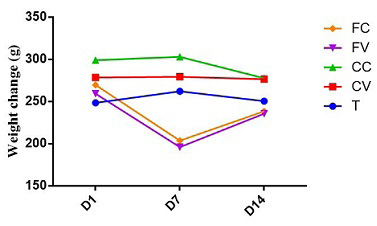
Figure 1: Weight change of the control rats (T), of the rats of the groups: vehicle control (CV), curcumin control (CC), vehicle formaldehyde (FV), and curcumin formaldehyde (FC). The results are expressed as an average.
Comparing the evolution of the weight from day 7 to day 14, the results underline a very highly significant difference (p<0.01) between the means of the batch (FV) that revealed low means on D7 with (196.0±4.733 N= 5) and high means on D14 (235.8±3.072 N= 5), and a significant difference (p≤0.05) between the batch means (FC) on D7 and D14 successively of (203.8±7.612 N= 5), (238.6±7.047 N= 5).
Our results also showed a significant difference (p< 0.01) with the higher means in the batch (CC) on D7 (303.0±7.092 N= 5) against (277.8±5.580 N= 5) on day 14.
Variation of the open field test parameters
Number of tiles crossed
Figure 2 illustrated the locomotion performance of rats in the number of cells crossed in the open field device established in 2 sessions D7 and D14. On D7 the results showed a highly significant difference (p<0.01) between the mean of the lot (FV) (50.20±10.75 N= 5) and the control lot (T) (102.0±15.72 N= 5), thus a significant decrease (p≤0.05) in (HR) (33.00±6.979 N= 5) as compared to (T) (102.0±15.72 N = 5).
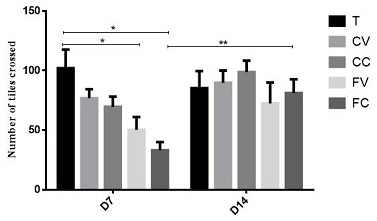
Figure 2: The number of cells crossed control rats (T), rats of the batches: vehicle control (CV), curcumin control (CC), vehicle formaldehyde (FV), and curcumin formaldehyde (FC). The results are expressed. on average ± SEM.
On D14 the histogram revealed some lower number in crossing cells in the two treated batches (FV) and (FC) with an average of (72.40±17.57 N= 5) and (81.20±11.53 N= 5) compared to (T) whose mean was (85.20±14.39 N= 5). The comparison of the batches between D7 and D14 highlighted a highly significant difference (p<0.01) between the batch (FC) of the 2 sessions and an average of (81.20±11.53 N= 5) on D7 and (33.00±6.979 N= 5) on D14.
Number of adjustments
Figure 3 illustrated the exploration performance of the rats in the number of right operations in the open field device in 2 sessions on D7 and D14. On the 7th day, a significant decrease (p≤0.05) was noted between the batch (CC) and (T) with an average of (9.200±1.020 N= 5) and (14.40±1.166 N= 5), as well as, a significant decrease (p≤0.05) in the batches FV (8.200±2.154 N= 5) and FC (7.600±1.030 N= 5) compared to T (14.40±1.166 N= 5). On day 14, the results showed a higher number of adjustments in the batch FC in front of the control T with respective means of (16.80±1.960 N= 5) and (14.60±1.720 N= 5). A significant difference (p≤0.05) of the lots CC on D7 and CC on D14 was listed with respective values of (9.200 ± 1.020 N = 5) and (13.80 ± 1.463 N = 5) and a highly significant difference (p<0.01) between the lot FC at D7 and FC at d14 and respective means of (7.600 ± 1.030 N = 5), (16.80 ± 1.960 N = 5) were also noted.
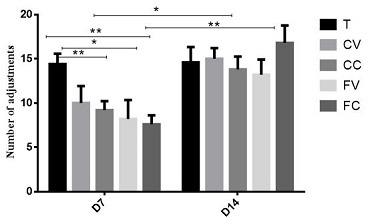
Figure 3: The number of recovery of the control rats (T), of the rats of the batches: vehicle control (CV), curcumin control (CC), vehicle formaldehyde (FV), and curcumin formaldehyde (FC). The results are expressed as the mean ± SEM.
Variation of the parameters of the object recognition test
Familiar object
Figure 4 clearly showed a difference between the means of the time spent with the familiar object for the two sessions of D7 and D14 from which we noted a significant difference greater in the groups FV (45.20 ± 4.488 N = 5) and FC (46.80 ± 6.111 N = 5) compared to batch T (28.00 ± 4.074 N = 5) in the first session.
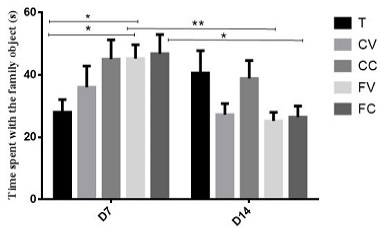
Figure 4: Variation of object recognition parameters (familiar object) in control rats (T), rats of the batches: vehicle control (CV), curcumin control (CC), vehicle formaldehyde (FV), and curcumin formaldehyde (FC). The results are expressed as the mean ± SEM.
For the second session (day 14) of the test, a non-significant decrease in this parameter was noted in the batch FV (25.20 ± 2.746 N = 5) and the batch FC (26.40 ± 3.586 N = 5) compared to batch T (40.60 ± 7.132 N = 5). The comparison of the two sessions allowed us to highlight a highly significant difference (p<0.01) in the time spent exploring the familiar object in the group FV on day 7 and the batch FV on day 14 with respective means of (45, 20 ± 4.488 N = 5) and (25.20 ± 2.746 N = 5), as well as, a significant difference (p≤0.05) between the batches FC on day 7 and FC on day 14 and means of (46.80 ± 6,111 N = 5) and (26.40 ± 3.586 N = 5) respectively.
New subject
Figure 5 revealed significant differences (p≤0.05) between the averages of the time spent with the new object of the five lots during the 2 sessions D7 and D14. the study also revealed a very highly significant difference (p<0.01) in the batches FV and FC with the means of (27.20 ± 4.465 N = 5) and (24.60 ± 5.862 N = 5) which were lower compared to T (116.4 ± 9.108 N = 5) at D7. From the same session, a significant decrease (p≤0.05) was observed in the batch CV (57.00 ± 8,112 N = 5) compared to the batch T (116.4 ± 9.108 N = 5). The same parameter was highly significant (p<0.01) at day 14 in the group FC (48.20 ± 8.766 N = 5) and lower than T (92.60 ± 3.140 N = 5). Between the two sessions of the batch CV, significant differences (p≤0.05) were notable with a low mean on D7 (57.00 ± 8.112 N = 5) and higher on D14 (90.60 ± 8.727 N = 5).
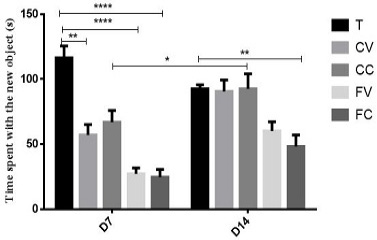
Figure 5: Variation of the object recognition parameters (new object) in the control rats (T), the rats of the batches: vehicle control (CV), curcumin control (CC), vehicle formaldehyde (FV), and formaldehyde curcumin (FC). The results are expressed as the mean ± SEM.
The results of our experiment showed that the administration of formaldehyde as a stressor causes a significant decrease in body weights compared to that of the control. This decrease, noted in rats treated with formaldehyde (FV) and (FC), can be explained by the decrease in food intake following intoxication induced by formaldehyde. Our results were in agreement with those reported by Mahmoud and Fenghour (2016) who reported a non-significant decrease in weight gain in the batches treated with AF.
Furthermore, the administration of curcumin to the rats after 7 days induced an increase in body weights, as some studies have shown that the administration of vitamin E and/or curcumin with Diaznon induced an improvement in daily food consumption rates and an increase in weight gains. This improvement was attributed to the protective effect of vitamin E, as well as, curcumin against the toxicity induced by pesticides (Fetoui et al., 2008; Ismail et al., 2009; Sankar et al., 2010). According to Soni and Kuttan (1992). On account of a decrease in body weight in the batch which received curcumin (CC) Some studies prove that curcumin reduces body weight gain and angiogenesis in adipose tissue, decreases pre-adipocytes differentiation and lipid accumulation in mature adipocytes in mice (Pulido-Moran et al., 2016).
The administration of formaldehyde caused stress. Indeed, some studies have demonstrated the link between chronic exposure to AF and the pathological consequences in terms of cancers, teratogenic effects, and neurodegenerative and vascular diseases (Gulec et al., 2006).
Stress induces a tendency to aggressiveness (Barreto-Medeiros et al., 2007; Veenema and Neumann, 2007) and in particular, an increase in the level of anxiety evaluated in the open field test, which makes it possible to measure the emotional state of the anxiety type, as well as, the level of locomotor activity and exploratory of the animal. It was used to assess an animal’s reaction to a new and spacious environment. It creates a situation of conflict between the animal’s natural tendency to explore this new environment and its aversion to open spaces.
In the current study, two parameters of the open field were taken into account; the number of rights and the distance traveled. The results reported on the 7th day a lower recovery number in the group FC and FV of rats stung with formaldehyde in front of the control (T). Similarly, for the same batches, a highly significant reduction in the number of cells crossed compared to the control was noted. Prut and Belzung (2003) explained that a reduction in the number of boxes crossed in the open field indicated a decrease in motor activity characteristic of a higher level of anxiety in these animals, which supported the high level of anxiety recorded as a result of the acute stress caused in rats.
An improvement in the behavior of the rats after administration of curcumin mainly in the batch FC was noted. Lee and Lee (2018) examined the effects of curcumin (20, 50, or 100 mg/kg, i.p., once daily) for 14 days after exposure to stress on symptoms of anxiety in rats showed the dysfunction of serotonin (5-HT). The administration of Curcuma longa significantly increased the number of cells crossed in the open field test.
The object recognition test, which relies on the tendency of rodents to interact more with a new object than with a familiar object, assesses short-term memory by testing the animal’s ability to remember an object already encountered (Leger and al., 2013). Our results indicated that for the rats that were treated with formaldehyde, they tend to explore the old object rather than the new one, indicating that rats were depressed, which causes memory disturbances. One study showed that rodents inhaled with a formaldehyde concentration of (2ppm) exhibited cognitive impairment during the object recognition test. Li et al. (2016) reported that behavioral analysis studies have shown that oral administration of 15 mg/kg diisodecyl phthalate (DIDP) combined with inhalation of 1mg AF led to memory impairment in the patient mouse. The histopathological observations of the brain from this study showed that the pathological changes are located in the hippocampi (Ge et al., 2019). The hippocampus plays an important role in consolidating information from short-term memory to long-term memory and spatial learning in humans and other animals (Lieberwirth et al., 2016). Several studies have shown that exposure to AF can induce a deficit in spatial learning and memory (Malek et al., 2002; Lu et al., 2008). Li et al. (2016) injected formaldehyde into mice intraperitoneally (once a day) for 7 days, the mice treated with formaldehyde became hypersensitive and easily irritated, in addition to slower learning in the “shuttle box”.
After the administration of Curcuma longa, we were able to note progress, which led the rats to explore the new object and to give less importance to the familiar object. This supports the existence of a correction in the central nervous system and more specifically in the hippocampus. Numerous studies have reported that curcumin protects the cerebellum, granule cells, hippocampus cells, and retinal cells against the excitotoxicity of glutamate (Matteucci et al., 2011; Bavarsad et al., 2018). Our results were synchronized with those whose aim was to evaluate the influence of subchronic cobber (Cu) intoxication (0.125%) for 6 weeks on the serotoninergic system, the state of anxiety, as well as, the spatial learning and memorization performance, and treated with (30 mg/kg body weight) curcumin. In rats exposed to Cu, the results revealed that curcumin might be useful in treating anxiety disorders caused by metallic elements by acting as an anxiolytic agent and in improving memory performance (Abbaoui and Gamrani, 2019). An earlier study determined that curcumin might improve cognitive impairment by acting through the brain-derived neurotrophic factor (BDNF) system in a head trauma model (Wu et al., 2006; Hueston et al., 2017).
In this sense, a very highly significant increase in the time spent with the new object in the rats having received an intraperitoneal injection of AF could be recorded after treatment with curcumin.
Conclusion
In our study, we investigated the effects of formaldehyde on anxiety and cognitive ability in male rats of the Wistar strain and changes in body weight. The product chosen during the therapy is turmeric Curcuma longa, which is one of the spices used as a natural treatment.
The behaviour of the rats was measured by behavioural tests: the open-field test to measure the level of anxiety, and the object recognition test to measure the level of cognition. The results clearly show the effectiveness of turmeric in the prevention of behavioral disorders and its ability to improve the damage on the weight associated with the administration of formaldehyde.
AUTHOR’S CONTRIBUTIONS
All authors contributed equally in all steps of laboratory.
CONFLICT OF INTEREST
The authors have declared no conflict of interest.
ETHICAL STATEMENT
All applicable international, national and/ or institutional applications guidelines for the care and use of Rats were followed. Within our laboratory.
REFERENCES





